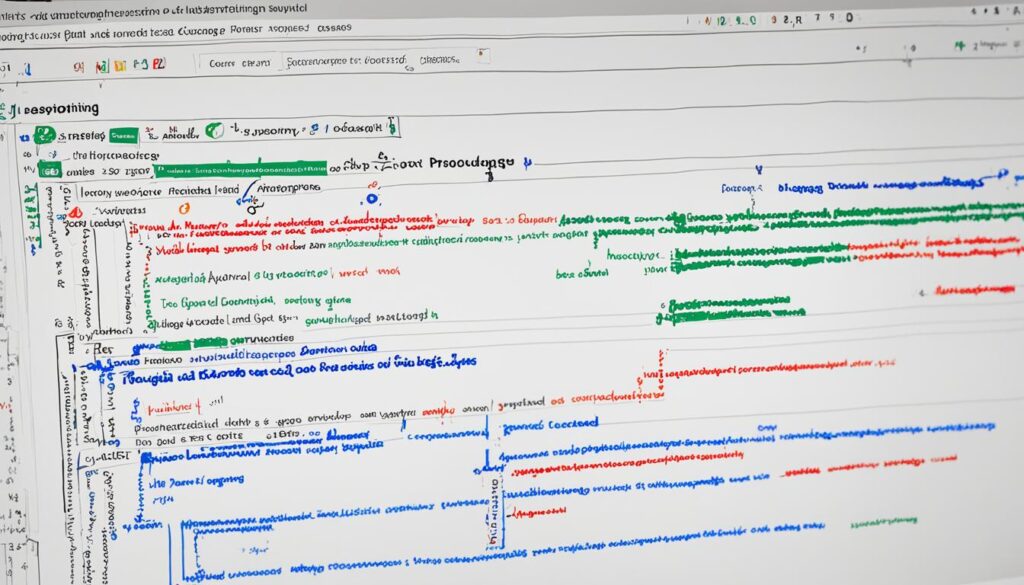Welcome to our article on Assertion Debugging and Coverage Analysis. In the realm of software development, ensuring software quality and testing efficiency are paramount. This is where Assertion Debugging and Coverage Analysis come into play. These techniques allow developers to identify and fix inconsistencies in program logic while measuring the extent to which the code is executed during testing.
By employing effective Assertion Debugging and Coverage Analysis methods, developers can enhance software quality and streamline the testing process. This results in improved code reliability, reduced time and effort spent on testing, and ultimately, a more robust software system.
In the sections to follow, we will delve deeper into the concept of Assertion Debugging and Coverage Analysis, exploring their definitions, techniques, methods, benefits, and best practices. Through this comprehensive exploration, we aim to provide you with valuable insights and knowledge that can be applied to your software development endeavors.
Let’s begin our journey into the world of Assertion Debugging and Coverage Analysis.
Table of Contents
What is Assertion Debugging?
In software development, Assertion Debugging is a critical process that helps identify and fix inconsistencies or errors in program logic. It involves the systematic examination of assertions, which are statements that assert the expected behavior of a program at a particular point in its execution.
By implementing assertions throughout the code, developers can validate assumptions, detect and handle unexpected conditions, and ensure the code is functioning as intended. Assertion Debugging plays a vital role in improving software quality and enhancing testing efficiency.
During the Assertion Debugging process, developers can analyze the program’s behavior and compare it against their expectations. If an assertion fails, it indicates an issue in the code that needs to be addressed. With proper debugging techniques and tools, developers can pinpoint the root cause of the problem and make the necessary corrections to ensure the program performs as expected.
By utilizing Assertion Debugging techniques, developers can uncover bugs and errors early in the development cycle, reducing the time and effort spent on testing and enhancing the overall software quality. It allows for more effective troubleshooting and helps prevent issues from propagating to later stages of development, where they might be more challenging to fix.
The Role of Coverage Analysis in Software Testing
In software testing, coverage analysis plays a vital role in ensuring the reliability and effectiveness of the testing process. It involves measuring the extent to which the source code is executed during testing, providing valuable insights into the areas that require further attention.
Enhancing Testing Effectiveness
Coverage analysis allows us to assess the thoroughness of our testing efforts by analyzing the code paths covered during test execution. By identifying untested or underrepresented portions of the code, we can prioritize our testing efforts and allocate resources effectively. This ensures that critical functionalities are adequately tested, reducing the risk of undetected software defects.
Identifying Uncovered Areas
Through coverage analysis, we can identify areas of the source code that have not been exercised during testing. These areas, commonly referred to as “coverage gaps,” may contain potential defects or untested program logic. By pinpointing and addressing these gaps, we can enhance the overall test coverage and increase the likelihood of detecting bugs or vulnerabilities in the software.
Measuring Quality and Test Completeness
Coverage analysis provides us with quantitative data on the percentage of code coverage achieved during testing. This metric serves as an indicator of the software’s quality and test completeness. By aiming for high coverage percentages, we can ensure that a significant portion of the code has been thoroughly tested, reducing the chances of critical issues remaining undetected.
Optimizing Testing Efforts
By analyzing different coverage metrics such as statement coverage, branch coverage, and path coverage, we gain valuable insights into the effectiveness and adequacy of our test cases. This analysis helps us identify redundant or ineffective test cases, allowing us to optimize our testing efforts and focus on areas that provide the most value in terms of identifying potential defects.
| Coverage Metric | Definition |
|---|---|
| Statement Coverage | Measures the percentage of code statements executed during testing. |
| Branch Coverage | Measures the extent to which all possible branches in the code have been exercised. |
| Path Coverage | Measures the level of coverage achieved by testing all possible execution paths through a function or module. |
Techniques for Assertion Debugging
When it comes to Assertion Debugging, employing the right techniques is crucial to identify and resolve assertion failures effectively. In this section, we will explore various approaches that can be utilized to ensure accurate and reliable software development.
1. Static Analysis: This technique involves analyzing the source code without executing it. By examining the code structure, syntax, and dependencies, developers can identify potential issues in assertions and logic. Static analysis tools, such as Eclipse IDE and FindBugs, can be used to automate this process, enabling comprehensive error detection.
2. Dynamic Analysis: In contrast to static analysis, dynamic analysis involves running the code and executing relevant test cases. By monitoring the code execution, developers can uncover assertion failures and other inconsistencies in real-time. Techniques like instrumentation and trace analysis can aid in this process, helping pinpoint the root cause of errors.
3. Runtime Monitoring: This technique involves continuously monitoring the execution of a software system to detect and handle assertion failures. By setting up runtime monitors and system-wide debugging tools, developers can capture and analyze runtime data, ensuring that assertions are evaluated correctly at runtime.
By utilizing a combination of these techniques, developers can enhance their debugging process and effectively address assertion failures. It is important to choose the appropriate technique based on the complexity of the code, the nature of the project, and the desired level of precision.

Methods of Coverage Analysis
When it comes to evaluating the thoroughness of testing in software development, Coverage Analysis plays a crucial role. It helps us understand how much of the source code is exercised during testing, enabling us to identify areas that may require further attention. In this section, we will explore different methods used for Coverage Analysis, including statement coverage, branch coverage, and path coverage.
Statement Coverage
One of the primary methods of Coverage Analysis is statement coverage. This technique focuses on ensuring that each statement in the source code is executed at least once during testing. By examining the coverage of individual statements, we can gain insights into the effectiveness of our test suite and pinpoint any areas that may have been overlooked.
Branch Coverage
Branch coverage, also known as decision coverage, is another method used to assess the thoroughness of testing. This technique aims to examine every possible branch or decision point in the source code. By analyzing branch coverage, we can determine whether all possible program paths have been tested, ensuring that different conditions and outcomes are adequately evaluated.
Path Coverage
Path coverage is a more comprehensive method of Coverage Analysis that focuses on analyzing all possible execution paths through the source code. This approach aims to test every unique combination of decision outcomes, allowing us to gain deeper insights into the behavior of the software. By considering path coverage, we can uncover potential issues or edge cases that may not be caught by other methods.
By utilizing these different methods of Coverage Analysis, we can gain a comprehensive understanding of the effectiveness and thoroughness of our testing efforts. The table below summarizes the key differences between statement coverage, branch coverage, and path coverage:
| Method | Focus | Advantages |
|---|---|---|
| Statement Coverage | Individual statements | Quickly identifies untested code |
| Branch Coverage | Decision points and branches | Detects gaps in decision coverage |
| Path Coverage | All possible execution paths | Ensures thorough testing of complex code flows |
By employing these different methods appropriately, we can ensure that our testing efforts are comprehensive and effective, helping us deliver high-quality software that meets the needs and expectations of our users.
Benefits of Assertion Debugging and Coverage Analysis
In software development, the utilization of Assertion Debugging and Coverage Analysis brings numerous benefits. These techniques not only enhance the quality of code but also increase reliability and efficiency in testing. Let’s delve into the advantages they offer:
1. Improved Code Quality
By employing Assertion Debugging and Coverage Analysis, developers can identify and resolve issues early in the development process. Assertion Debugging helps catch inconsistencies or errors in program logic, ensuring robust code that meets expected functionality. Meanwhile, Coverage Analysis measures the execution of source code, guaranteeing thorough testing and uncovering potential areas for improvement.
2. Increased Reliability
Assertion Debugging and Coverage Analysis play a vital role in ensuring the reliability of software systems. Assertion Debugging helps developers identify and correct program errors, reducing the likelihood of system failures. Furthermore, Coverage Analysis ensures that all critical parts of the code are thoroughly tested, minimizing the probability of undetected bugs.
3. Reduced Time and Effort Spent on Testing
Assertion Debugging and Coverage Analysis contribute to improved testing efficiency. Assertion Debugging allows developers to pinpoint errors quickly, streamlining the debugging process and reducing debugging time. Coverage Analysis helps prioritize testing efforts by identifying code areas that receive optimal coverage, allowing developers to focus on critical sections and minimize redundant testing.
Overall, the integration of Assertion Debugging and Coverage Analysis in software development leads to higher code quality, increased reliability, and more efficient testing processes. These techniques empower developers to deliver software solutions that meet or exceed stakeholders’ expectations.

Best Practices for Assertion Debugging and Coverage Analysis
When conducting Assertion Debugging and Coverage Analysis, it is essential to follow best practices to ensure effective implementation. These practices will help you identify and resolve issues efficiently, leading to improved software quality and testing efficiency. Here are some key best practices to consider:
1. Set Clear Objectives
Before embarking on Assertion Debugging and Coverage Analysis, clearly define your objectives. Determine what specific issues or areas you want to address and what insights you aim to gain from the analysis. This will provide a direction and focus for your testing efforts.
2. Select Appropriate Tools
Choose the right tools for Assertion Debugging and Coverage Analysis based on your project requirements. There are various debugging tools and coverage analysis tools available in the market, each with its own set of features and capabilities. Evaluate and select tools that align with your project’s needs and are compatible with your development environment.
3. Develop Comprehensive Test Cases
Create thorough and comprehensive test cases that cover different scenarios and use cases. Well-designed test cases ensure adequate coverage and help identify both expected and unexpected behaviors. Consider various inputs, edge cases, and boundary conditions to ensure a comprehensive analysis.
4. Regularly Review Assertions and Coverage Metrics
Review your assertions and coverage metrics regularly during the development and testing process. Monitor assertion failures and coverage gaps to identify patterns or recurring issues. This will help you fine-tune your testing strategies and address any gaps promptly.
5. Collaborate with Developers and Testers
Collaboration between developers and testers is crucial for successful Assertion Debugging and Coverage Analysis. Foster open communication and encourage feedback and suggestions from both parties. Developers can provide insights into the codebase, while testers can offer valuable perspectives from a testing standpoint.
6. Automate the Process
Automate the Assertion Debugging and Coverage Analysis process where possible. Utilize automated testing frameworks, tools, and scripts to streamline and accelerate the testing process. This not only saves time but also reduces the chances of human errors and facilitates consistent and repeatable analysis.
7. Document and Share Findings
Document the findings, insights, and recommendations from your Assertion Debugging and Coverage Analysis. Maintain clear and organized documentation that can be easily accessed and shared with the development team. This promotes knowledge sharing, facilitates future debugging and analysis, and ensures continuity in software quality improvement efforts.
By following these best practices, you can enhance the effectiveness and efficiency of Assertion Debugging and Coverage Analysis, leading to better software quality and streamlined testing processes.
Conclusion
In conclusion, Assertion Debugging and Coverage Analysis are powerful techniques that contribute to the improvement of software quality and testing efficiency. By implementing these practices and following best practices, developers can ensure the creation of robust and reliable software systems.
Assertion Debugging enables developers to identify and fix inconsistencies or errors in program logic, leading to more stable and predictable software behavior. Coverage Analysis, on the other hand, helps evaluate the adequacy of testing by measuring the extent to which the source code is executed. This allows developers to identify areas requiring further testing and enhance the overall testing strategy.
By adopting Assertion Debugging and Coverage Analysis, developers can reduce the occurrence of bugs, enhance code quality, and ultimately deliver higher-performing software. These techniques assist in the early detection and resolution of issues, saving time and effort in the testing phase. In addition, they help uncover critical vulnerabilities and prevent potential software failures before they impact end-users.

